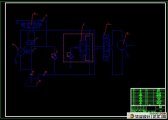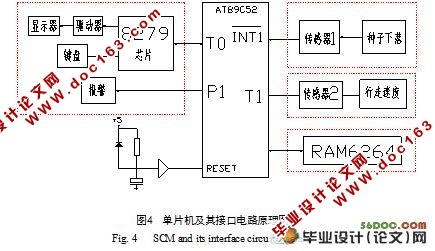液压控制变量播种系统设计及试验研究

液压控制变量播种系统设计及试验研究(论文说明书23000字,cad图纸1张)
摘 要:精准农业是当今世界农业发展的新潮流,是由信息技术支持的根据空间变异,定位、定时、定量地实施一整套现代化农事操作技术与管理的系统,其基本涵义是根据作物生长的土壤性状,调节对作物的投入。播种机工作性能的优劣将直接影响到播种作业生产率及谷物出苗的质量。对播种机来说,排种器是它的核心部件,它对播种的质量起决定性作用。所以本文在对目前国内外播种机排种控制系统进行大量比较分析的基础上,研究设计了一种播种机排种自动控制装置并且能够实现变量播种的装置。本系统采用液压马达控制驱动排种器,可以通过调节阀块来实现不同状况下要求的播种量,液压马达和排种器转速与播种机作业速度一致。
关键词:精准农业; 排种器; 液压系统; 变量播种
Design of HydraulicVariables Control System and Test of Seeding
Abstract:Precision agriculture is the world's new trend of agricultural development, information technology support is the basis for spatial variability, location, timing, implementation of a set of quantitative operation of modern agricultural technology and management system, its basic meaning is based on crop growth, soil properties, regulation of crop inputs. Planter performance will directly affect the merits of planting corn seedling productivity and job quality. On the planter, the metering device is its core component, it played a decisive role in the quality of planting. So this drill at home and abroad in the control system for a large number of seed on the basis of comparative analysis to study the design of a seed planter and automatic control device to achieve variable seeding device. The motor control drive system uses hydraulic metering device can be achieved through the control valve blocks the requirements of different seeding rate conditions, the hydraulic motor and speed metering device consistent with the seeder operating speed.
[来源:http://Doc163.com]
Key words:precision agriculture;metering;hydraulic system;variable seeding
1.4 研究的意义
我国当前面临农业资源匮乏、农田环境污染严重的问题,另外加入WTO农业市场竞争激烈,因此在我国实施精准农业示范和研究工作具有重要的战略意义,将大力促进农业的可持续发展,而精量播种技术的研究是其重要组成部分之一。它能调动土壤生产力,以最少的或最节省的投入达到同等收入或更高的收入,并改善环境,高效地利用各类农业资源,取得经济效益和环境效益。
2 排种器的选择
排种器是种子群体与植株个体之间的转换环节,其前端是混沌的不定量集合散粒体,不具有个体属性和农艺栽培所必须的播种属性,不能赖以出苗成长或收获。只有当定量分离的种子被先后有序的定植于土壤中特定的坐标位置以后,种子才最终获得了播种属性。因此,排种器是播种机的核心和关键部件。
2.1 排种器的技术要求
排种器的技术要求大体上有以下几个方面:
1. 排种器排种均匀稳定,排种均匀性不受外界条件变化而产生严重影响。一台播种机的排种量应保持一致。
2. 不损伤种子。 [来源:http://www.doc163.com]
3. 播种调节范围要大。
4. 通用性好。
5. 工作可靠,不易堵塞。



目 录
摘 要……………………………………………………………………………… 1
关键词……………………………………………………………………………… 1
1 前言……………………………………………………………………………… 2
1.1 绪论…………………………………………………………………………2
1.2 我国播种机发展现状………………………………………………………3
1.3 国内外研究及应用概况……………………………………………………4
1.4 研究的意义…………………………………………………………………4
[资料来源:https://www.doc163.com]
2 排种器的选择…………………………………………………………………… 4
2.1 排种器的技术要求…………………………………………………………4
2.2 排种器结构设定……………………………………………………………5
2.3 排种器工作原理……………………………………………………………6
2.4 排种器工作特点……………………………………………………………6 [版权所有:http://DOC163.com]
2.5 排种器相关参数分析……………………………………………………… 6
2.5.1排种轮角速度和角转速的确定……………………………………6
2.5.2 计算每米播种的籽粒数………………………………………………7
2.5.3 排种轮上窝眼数的确定…………………………………………………7
3 播种机排种过程的影响与分析………………………………………………… 7
3.1 影响播种量的主要因素…………………………………………………… 7 [来源:http://www.doc163.com]
3.1.1 机具前进速度的影响……………………………………………………7
3.1.2 排种器类型的影响………………………………………………………8
3.1.3 排种器转速与排种实验……………………………………………… 9
4 液压系统的设计及其整体方案确定……………………………………………10
4.1 液压系统设计要求…………………………………………………………10 [来源:http://www.doc163.com]
4.2 液压控制变量播种液压系统设计的主要内容……………………………10
4.3 液压系统组成………………………………………………………………10
4.4 确定液压系统的压力和流量………………………………………………12
4.5 各主要液压器件选择及其工作原理………………………………………12
4.5.1 变量柱塞泵……………………………………………………………12
4.5.2 液压马达………………………………………………………………13 [来源:http://www.doc163.com]
4.5.3 电磁换向阀…………………………………………………………14
4.5.4 溢流阀…………………………………………………………………14
5 控制系统的设计………………………………………………………………… 14
5.1 控制对象及要求……………………………………………………………14
5.2 控制装置的硬件设计………………………………………………………15 [资料来源:http://doc163.com]
5.2.1 单片机最小应用系统…………………………………………………15
5.2.2 传感器系统电路的设计………………………………………………16
5.2.3 播种量信号的输入……………………………………………………17
5.2.4 控制脉冲的输出………………………………………………………19
5.2.5 直流稳压电源…………………………………………………………19
5.3 软件编写与调试……………………………………………………………20
5.3.1 单片机调频原理及实现步骤…………………………………………20
5.3.2 查表方式及表格数据的确定…………………………………………20
5.3.3 控制系统流程………………………………………………………21
5.4 系统硬件抗干扰措施……………………………………………………… 23 [来源:http://www.doc163.com]
5.4.1 供电装置………………………………………………………………23
5.4.2 接地线设计……………………………………………………………23
5.4.3 去耦电容配置…………………………………………………………23
5.4.4 光电耦合器……………………………………………………………24
5.5 系统软件抗干扰设计……………………………………………………… 24 [来源:http://www.doc163.com]
5.5.1 指令冗余措施…………………………………………………………24
5.5.2 软件陷阱的设计………………………………………………………24
6 试验及分析………………………………………………………………………25
6.1试验设备………………………………………………………… 25
6.2 试验材料……………………………………………………………………27 [资料来源:www.doc163.com]
6.3 试验系统工作方法原理……………………………………………………27
6.4排种器排种性能试验……………………………………………………… 27
6.4.1 排种器排种均匀性分析………………………………………………27
6.4.2 排种器各行排量一致性分析…………………………………………31
6.4.3 排种器转速与播量的关系……………………………………………32 [资料来源:www.doc163.com]
6.4.4 不同转速下播量的误差分析……………………………………33
6.4.5 液压马达转速验证……………………………………………………34
6.4.6 试验结论………………………………………………………………35
7 总结………………………………………………………………………………36
7.1 课题设计的优缺点………………………………………………………… 36 [版权所有:http://DOC163.com]
7.2 课题结论与讨论…………………………………………………………… 36
参考文献…………………………………………………………………………… 37
致谢………………………………………………………………………………… 38 [版权所有:http://DOC163.com]
